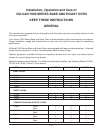
— 15 —
CLEANING
WARNING: TURN OVEN OFF AND UNPLUG THE ELECTRICAL CORD (IF APPLICABLE) BEFORE
CLEANING.
Clean interior and exterior of oven daily with warm water and detergent solution. Rinse thoroughly and
wipe dry with a soft clean cloth.
Oven Inspection Window (Optional)
The oven inspection window may be cleaned with an oven cleaner compound or with a cloth dampened
with detergent solution. Rinse thoroughly and dry with a soft clean cloth. Do not use scouring powder
on the window; it will scratch and fog the glass, and it is easy to build up an accumulation of excess
scouring powder which is extremely difficult to remove.
Stainless Steel (Optional)
Clean stainless steel with soap or detergent and water solution. Rinse thoroughly with warm water and
wipe dry with a soft clean cloth. Addition of a rinsing agent will also help prevent spotting.
Stubborn stains that resist soap and water usually can be removed with a paste of water and mild
scouring powder. When applying these powders, be sure to rub in the direction of the polish lines on
the steel to preserve the original finish.
Fingerprints on highly polished surfaces of stainless steel can be minimized by applying a cleaner that
will leave a thin, oily or waxy film. Apply cleaner and remove excess with a soft dry cloth. After using,
subsequent fingerprints will usually disappear when wiped lightly with a soft dry cloth or with a cloth
containing a little of the cleaner. If the surface is especially soiled to start with, wash first with soap
or detergent and water.
To remove burned on foods and grease, soak with hot soapy water first. Using stainless steel wool
or a sponge, apply a paste of scouring powder and water. Rub in the direction of the polish lines. Do
not use ordinary steel wool on stainless steel surfaces. These particles can eventually rust and cause
unsightly spots and stains. Rinse thoroughly and wipe dry with a soft clean cloth.
In and around ovens where temperatures reach 500°F or more, straw-colored or slightly darkened
areas may appear on stainless steel. This "heat tint" is caused by a slight oxidation of the stainless
steel and is not harmful. To control or minimize this condition, never use more heat than is absolutely
necessary. Heat tint can be removed by scouring vigorously with stainless steel wool and a paste made
of a scouring powder and water. Again, remember to rub in the direction of the polish lines. Rinse
thoroughly and wipe dry with a soft clean cloth.
When scraping off heavy deposits of grease or oil from stainless steel equipment, never use ordinary
steel scrapers or knives. Particles of ordinary steel may become embedded in, or lodge on, the surface
of the stainless steel. These will rust, causing unsightly stains. Where it is necessary to scrape, use
stainless steel, wood, plastic or rubber tools.


















